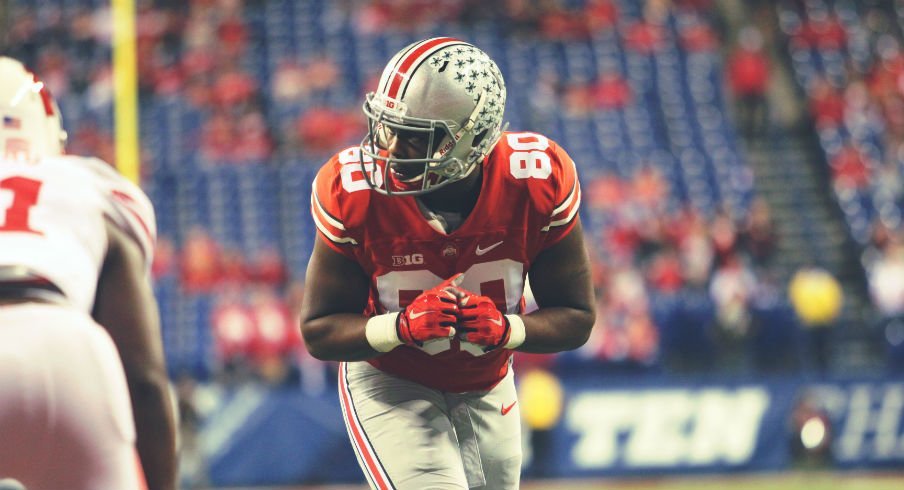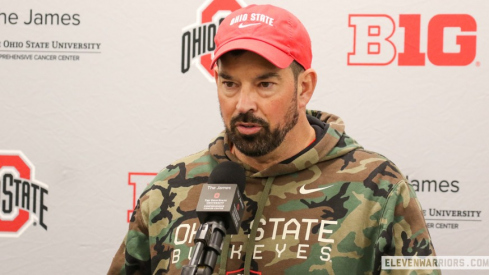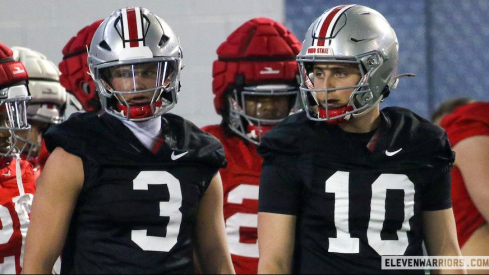With his aggressive philosophy, Ohio State receiver coach Zach Smith has elevated his unit and staked claim to the title of 'Wide Receiver U.' The dynamic unit leader will be put to the test this season as he coaches up a young inexperienced group of pass-catchers for the physicality of big-boy college football. How will Smith prepare them for the pressure they will face every game? It all starts on the line of scrimmage.
As a former wide receivers coach, Ohio State head coach Urban Meyer expects the unit to make plays (Eleven Warriors' D.J. Byrnes recently posted several videos of Meyer coaching up pass-catchers during his time in the role at Notre Dame). There is no learning on the job in a program competing for the Big Ten title and a spot in the College Football Playoffs year in and out.
In what is quickly becoming an annual tradition, Meyer had some tough words for the unit during Spring practice. In response to a question regarding the wide receivers’ progression and preparedness for the upcoming season, he noted "After you've been here six months, if you're tagged with the term, 'you have a lot of potential,' that's really a bad thing. That means you're not very good, but you should be.”
Entering his 15th year as a head coach, Meyer knows the importance of a well-functioning passing game in his power-spread offense. A major component of his offensive identity is to pound away with a relentless running game, before taking the top off the defense with vertical routes off play action. Without legitimate downfield threats opposing defenses will sit on the vaunted Buckeye ground attack (see Ohio State’s lone regular season loss to Big Ten Champion Michigan State), clogging run lanes and rendering a dynamic offense one-dimensional.
With all that said, where will the production come from?
This year’s NFL draft demonstrated just how dominant the previous group was, as five of last season’s top six pass-catchers now sit on an NFL roster (returning junior Curtis Samuel was fourth on the team with 22 receptions). With over 80% of last season’s production departed for the NFL—and no returning starters—the opening week match-up with a Bowling Green squad that can score points in bunches looms.
Enter the Dublin, Ohio native Smith, a former quality control coach and graduate assistant under Meyer at Florida. After stops at Temple and Marshall, the young coach was brought on board to run the pass-catching unit in 2012. Ohio State’s three-time National Champion head coach knows exactly what he has in his well-respected assistant.
When putting together his initial staff after his 2012 hire, Meyer did not mince words about the importance of Smith’s hire.
After referring to the unit as “the least prepared group I’ve ever been around," Meyer went on to praise the new coach, saying “I know what a quality coach Zach is. He knows my system inside and out and he teaches the system the way I want it to be taught."
The up-and-coming coach has quickly built a recognizable brand around his unit, with current and former players swamping social media with his patented #Zone6 and #shhh hashtags. With the emphasis on ‘former’ players, Smith has his work cut out for him.
So how will opposing defensive coordinators attack his group of young wideouts?
The easiest way to get into a young player’s head is to bully him at the line of scrimmage from the first snap. If a wide receiver cannot get off the line of scrimmage, he cannot run his route and cannot get open. It is that simple.
Eleven Warriors previously analyzed press coverage philosophy and technique from a defensive perspective using current New York Giant cornerback Eli Apple. We now move on to countering this aggressive brand of pass defense at the line of scrimmage by breaking down wide receiver ‘releases.’
A release refers to how the wideout exits the line of scrimmage. Does he cut inside? Outside? Straight upfield? While route running and yards after catch get most of the attention releases are a vital portion of the toolbox, as it is impossible to run a pass route or catch the ball if the cornerback has locked up the receiver at the line of scrimmage. Look at all the great NFL pass catchers and you will see players that have mastered the technique. Quietly, there is a great deal of detail and nuance to releasing off the line (one of the reasons many skill athletes fail to make the transition to wide receiver), hence the reason many teams will press young starters.
The basic tenant of beating press coverage is that the hands and feet must work together at all times. This is the key takeaway. Against lesser competition a player can get away with less-than-stellar technique, but to the beat the best the upper and lower body must work in conjunction. We will start our breakdown by looking at each component independently (like the skill is taught), then put them together to see how they look on the field.
Let’s start with the wide receiver stance:
- The front leg should be up on the line of scrimmage with the knees over the toes. Roughly 80% of the weight should rest on the balls of the feet to prevent rocking and false stepping
- The back leg is aligned straight back behind the receiver with the remaining body weight resting on the shoelace. The heel should be off the ground to aid in a quick first step
- The arms should never be down at the sides. Coaches will teach a variety of locations, but as long as the receiver's arms are above his waist he will be prepared to attack the cornerback’s hands.
- The hips and shoulders will be square and pointed straight downfield. If the upper and lower body are out of alignment the receiver limits his ability to execute a ‘three-way-go’ (release inside, outside, or straight upfield).
Some coaches will teach the pass-catcher to bring the back leg slightly forward and squared when facing press coverage. The altered stance can aid the receiver in the footwork he must execute at the line, but this coaching point varies by program.

Releasing against press coverage starts with the lower body. While there are a variety of techniques taught at all levels of football, a common release we see from Buckeye receivers every Saturday is the ‘Out-In’.
The out-in is a four-step release that uses a jab step and shoulder shake to force the defender to lean away from the intended release direction. It is often used when the receiver wants to force an inside release, commonly used when running in-breaking routes like the Slant, Dig, and Post.
The progression looks like this:
- Pushing off the inside foot, the receiver will take a hard jab step away from press cornerback with the outside foot. While the feet should not be parallel, the receiver must take care not to extend the outside foot too far away from the body or the center of gravity and balance will be compromised. While taking this step the skill player should give a hard shoulder shake while keeping the hips and shoulders in balance. If executed correctly the cornerback will often lean away from the release
- The second step will take the receiver back across the cornerback’s face to the inside. It is vital to explode off the outside foot here to clear the defender’s body.
- The third step, taking with the inside foot, should put the receiver ‘hip-to-hip’ on the defender.
- With the fourth step, the receiver wants to ‘stack’ the defender, or pass him by and get back on an imaginary line behind him.
Former Buckeye and current Saint Michael Thomas demonstrated the strength of outstanding footwork throughout the final season of his college career. We see a great example of an out-in release from the Ohio State’s mid-November 28-3 victory over Illinois.

The footwork happens VERY fast; if you blink you will miss it. We have slowed down the clip to show the detail and precision of the release.


Focus on the initial footwork as the first round draft pick jab steps to the outside, forcing the corner to lean the wrong way, before cutting back across his face to run a slant route.
A second out-in release we see Smith’s unit utilize is known in the program as a ‘gain two’. This release is particularly popular when running slant routes, as it opens the defenders hips away from the break and creates extra space for the wide receiver to run the route (hence the name).
The Michael Thomas 79-yard catch-and-run touchdown from the 2014 Ohio State-Michigan State contest provides a great example of the release.

The goal is to bring the feet square at the line of scrimmage, take three outside steps to open the corner’s hips, and cut back across his face on the third step to create separation. Pay attention to the defender’s hips as Thomas breaks towards the center of the field. Not only does he open his hips away from the route’s direction, but he is forced to flip 180 degrees to chase the receiver, creating plenty of room for the throw and putting the defender in trail position after the reception is made.
Once footwork is mastered, the emphasis moves on to the hands. Remember, in order to consistently defeat press coverage the hands and feet must work together.
The first move we will look at is well-known as defensive linemen technique, the 'Swat'. The goal of a swat is to smack down the cornerback’s arm with one hand while simultaneously swimming the second arm over the cornerback’s shoulder as he executes a hard punch, known as a ‘jam’.


Pay attention to the receiver’s hands as he cuts inside. The defender has made contact with Thomas as he releases, but a quick swat with the left hand while swimming with the right hand easily disengages the arms. This allows Ohio State’s leading receiver of the 2015 season to enter his route stem (break) unimpeded to make a seemingly easy catch for a first down.
A second technique we see the Buckeye receiving corps utilize is the 'Grab/Pull'. The technique works particularly well when the receiver possesses superior upper-body strength, using the advantage to toss the defender around like a rag doll.


Evan Spencer (best known for his soul-crushing block on an Alabama linebacker during Ezekiel Elliott’s 85-yard game-clinching touchdown run) executes the technique to perfection, drawing a flag for pass interference and putting his offense in position to tie the ball game. Focus on Spencer as he crosses the 30-yard line. He wants to break inside, but the Michigan State cornerback has cut-off the route with his body. Watch as the receiver first places his hand on the defender’s back to grab cloth and pull while concurrently swimming his outside arm over the shoulders. The defensive back is easily overpowered and resorts to grabbing the receiver’s leg in order to prevent the touchdown reception (the right move in this instance).
Coach Zach Smith will certainly earn his paycheck plus interest this year as he teaches and leads an inexperienced unit. While the group may lack live game reps, expect their fiery leader to continue pushing and preparing them through Summer training camp. Based on recent history, it is a safe bet to expect leaders from this new group to maintain and enhance the #Zone6 tradition.


